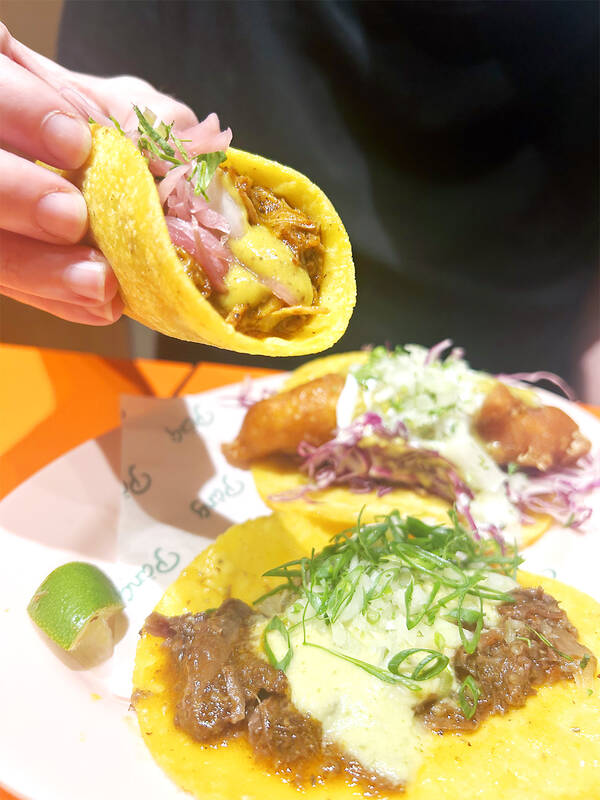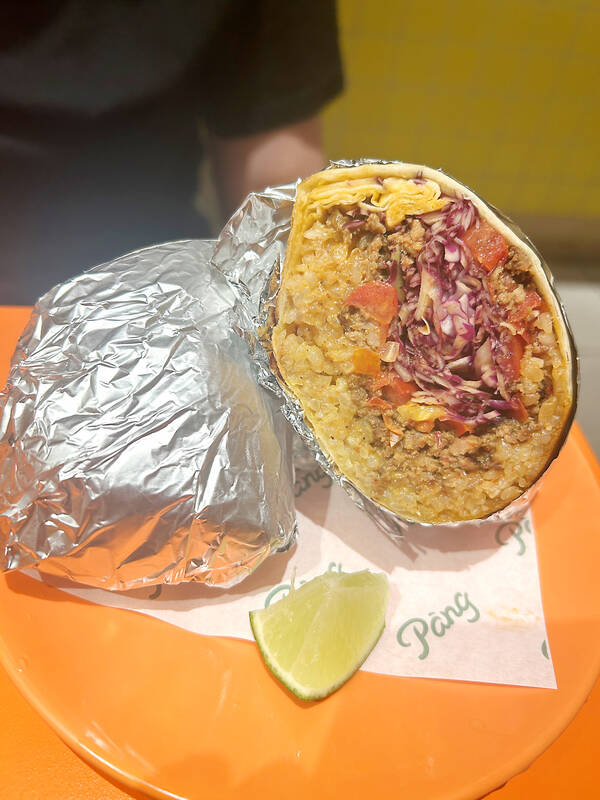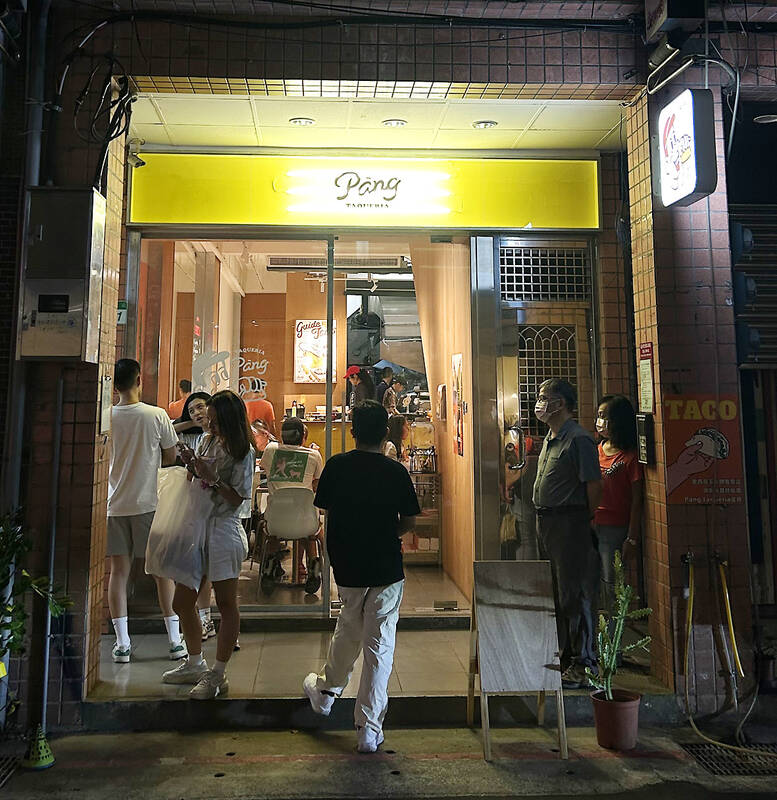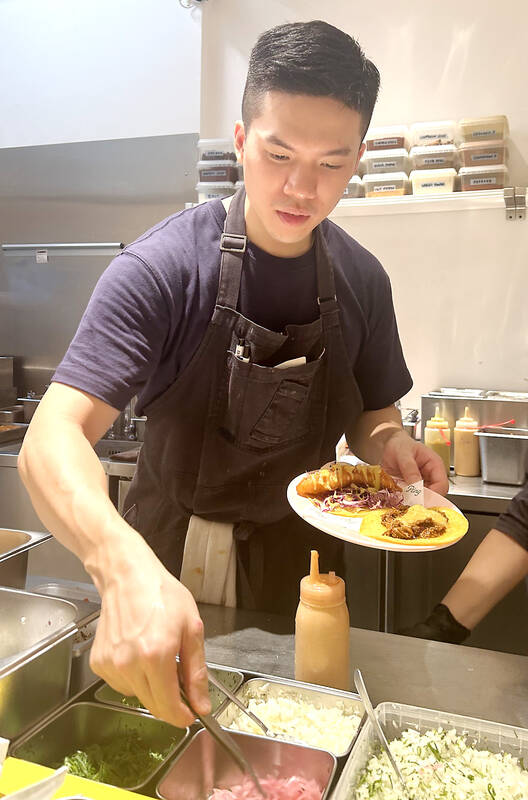This year’s Michelin Gourmand Bib sported 16 new entries in the 126-strong Taiwan directory. The fight for the best braised pork rice and the crispiest scallion pancake painstakingly continued, but what stood out in the lineup this year? Pang Taqueria (胖塔可利亞); Taiwan’s first Michelin-recommended Mexican restaurant.
Chef Charles Chen (陳治宇) is a self-confessed Americophile, earning his chef whites at a fine-dining Latin-American fusion restaurant.
But what makes this Xinyi (信義) spot stand head and shoulders above Taipei’s existing Mexican offerings? The authenticity. The produce. The care.

Photo: Hollie Younger
AUTHENTIC EATS
In my time on the island, I have caved too many times to expat pub grub in a quest to quench homesickness; not for the infamously flavorless cuisine of my homeland but the vibrant international fusion that now defines the London culinary scene.
In Taipei, I have watched my mulled wine clingfilmed and microwaved at the bar. I have borne insult to many a squid pizza. Don’t get me started on the Thai stir fries served with no chilies because “you’re a foreigner.”

Photo: Hollie Younger
As a Latin food lover, I’ve also endured many bland flour-tortillas stuffed with cheap cheese and unseasoned meat, wrapped up in the pillowy guise of a “Mexican burrito.” All this to say, I approached Pang Taqueria with a fair dollop of skepticism.
On first impressions, Pang is a small establishment that could house 20 small-framed patrons on a good day. The lights are bright, the tables are neon orange and the open kitchen gives more laidback lunch spot than fine dining. The inspiration is the taquerias of Mexico and the focus is the food. You will find no sombreros or Day of the Dead decor here.
But what identifies Pang, squeezed among furniture stores on a quiet alley by Linjiang Night Market, is the waiting crowd. Chen says business has picked up since his Michelin recognition, but Wednesday night’s 20-minute wait was well worth it.

Photo: Hollie Younger
PRODUCE MAKES PERFECT
Uniquely, Pang sources many Taiwanese ingredients and incorporates local flavors to Mexican classics. Take the Tripa taco with Taiwanese-style pork intestines (NT$140) and the horchata (NT$120) using rice milk from Taitung.
Chen says Mexico and Taiwan share many characteristics, from climate to produce to local palettes. His experience in Mexican cuisine also taught him a more carefree culinary attitude, “for us, tacos are just a vehicle for the flavors... what you put on it is limitless.”

Photo: Hollie Younger
Chen also uses locally-grown corn to hand-prepare masa dough for his in-house corn tortillas every day. In every taco, this perfectly dense, mealy wrap holds the staunch line of defense between his expert blends of saucy proteins and my t-shirt. No floppy tortillas here.
The Michelin guide showcases Chen’s signature cochinita pibil taco (NT$140): slow-cooked pork shoulder, house-made habanero salsa and hibiscus-pickled onion. It’s incredibly rich and complex — is that cinnamon? Can you taste nutmeg? Truly one of the most layered and harmonious flavor hits I’ve taken this year.
But what would keep me running back is the elote (NT$180), a grilled corn salad with crumbly feta, punches of onion and cilantro, a spicy crema I could have eaten by the bucket-load, and an addictive smokiness: these guys individually blowtorch each helping right at the open kitchen, and it’s not just for show. This is the must-eat on every table. Some couples have tucked into a bowl each.
My go-to order, and personal taco litmus test, is always a Baja fish taco (NT$150); a hearty chunk of beer-battered white fish slathered with sour cream, slaw and tangy pico de gallo. Chen’s holds its own with any I’ve tried, including in Baja birthplace San Diego. When you’re drowning fried foods in avocado crema and habanero oil, it’s difficult to stave off the sogginess. But Pang’s offering is perfectly crispy until the very last bite; they’re made to order and served up the second they add that last sprig of cilantro.
We also sampled the Birria taco (NT$140), a hearty stew of slow-cooked Australian beef cheek, and the Chorizo burrito (NT$330).
Two to three tacos per patron, and as much of the corn elote you can fit in, is the perfect order, washed down with a cool bottle of Corona (NT$150). The price is high for Taipei but an absolute steal for this level of craftsmanship, authenticity and world-class ingredients.
Even without the Bib gourmand, word of mouth is super-spreading across the city, and for good reason.
There was only one thing criminally missing at Pang’s, I thought, as I parked a seat at one of Xinyi’s many cocktail bars and finally sipped on an ice-cold margarita.

That US assistance was a model for Taiwan’s spectacular development success was early recognized by policymakers and analysts. In a report to the US Congress for the fiscal year 1962, former President John F. Kennedy noted Taiwan’s “rapid economic growth,” was “producing a substantial net gain in living.” Kennedy had a stake in Taiwan’s achievements and the US’ official development assistance (ODA) in general: In September 1961, his entreaty to make the 1960s a “decade of development,” and an accompanying proposal for dedicated legislation to this end, had been formalized by congressional passage of the Foreign Assistance Act. Two

Despite the intense sunshine, we were hardly breaking a sweat as we cruised along the flat, dedicated bike lane, well protected from the heat by a canopy of trees. The electric assist on the bikes likely made a difference, too. Far removed from the bustle and noise of the Taichung traffic, we admired the serene rural scenery, making our way over rivers, alongside rice paddies and through pear orchards. Our route for the day covered two bike paths that connect in Fengyuan District (豐原) and are best done together. The Hou-Feng Bike Path (后豐鐵馬道) runs southward from Houli District (后里) while the

March 31 to April 6 On May 13, 1950, National Taiwan University Hospital otolaryngologist Su You-peng (蘇友鵬) was summoned to the director’s office. He thought someone had complained about him practicing the violin at night, but when he entered the room, he knew something was terribly wrong. He saw several burly men who appeared to be government secret agents, and three other resident doctors: internist Hsu Chiang (許強), dermatologist Hu Pao-chen (胡寶珍) and ophthalmologist Hu Hsin-lin (胡鑫麟). They were handcuffed, herded onto two jeeps and taken to the Secrecy Bureau (保密局) for questioning. Su was still in his doctor’s robes at

Mirror mirror on the wall, what’s the fairest Disney live-action remake of them all? Wait, mirror. Hold on a second. Maybe choosing from the likes of Alice in Wonderland (2010), Mulan (2020) and The Lion King (2019) isn’t such a good idea. Mirror, on second thought, what’s on Netflix? Even the most devoted fans would have to acknowledge that these have not been the most illustrious illustrations of Disney magic. At their best (Pete’s Dragon? Cinderella?) they breathe life into old classics that could use a little updating. At their worst, well, blue Will Smith. Given the rapacious rate of remakes in modern